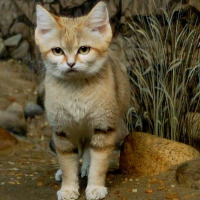 |
Sand Cat |
|
He is a wild animal |
Origin |
Desert regions of Africa and Asia | |
Translation |
Francis Vandersteen |
| The possession of this animal is not authorized Royal Decree establishing the list of mammals not kept for production purposes that may be kept (M.B. 24.08.2009) |
| The Sand Cat, also known as the Desert Cat, General Margueritte's Cat or Margueritte's Cat, lives in the desert regions of Morocco, Algeria, Tunisia, Libya, Egypt, Israel, Sudan, Niger, Saudi Arabia, Qatar, Oman, Yemen, Iran, Pakistan, Turkmenistan and Uzbekistan. The Sand Cat is the feline best adapted to very arid desert habitats. The coat of the Sand Cat is often sand-colored. Markings vary from individual to individual: some have no spots or stripes, others are lightly spotted, others have spots and stripes. It has blackish bars on the limbs, and the tail has a black tip with two or three dark rings alternating with buff stripes. This is a small cat with a broad, flat head, short legs and a relatively long tail measuring between 23 and 31 cm. It reaches a height at the withers of 24 to 36 cm and weighs 1.5 to 3.4 kg. Head and body length vary from 39 to 52 cm. The long ears (5 to 7 cm) give the head a flat, broad appearance. They are tawny at the base and spotted with black, and more pointed than those of the Pallas Cat. The ears are triangular and the auditory canal is very wide, giving the cat a better sense of hearing. The auditory bullae and passages from the outer ears to the eardrums are greatly enlarged compared to other small felids; the inner parts of the ears are protected from foreign objects by long white hairs close together. The large, greenish-yellow eyes are surrounded by white, and the nose is blackish. The head is sandy brown, while the upper and lower lips, chin, throat and belly are white. In some individuals, the throat has a hint of buff. The lower part of the face is whitish, and a faint reddish line runs from the outer corner of each eye across the cheeks. Its whiskers are white and up to 8 cm long. In northern regions, the Sand Cat's winter coat is very long and thick, with hair up to 5 cm long. The claws on the forelegs are short and very sharp, while those on the hind legs are small and blunt. The undersides of the legs are protected from extreme temperatures by a thick covering of fur. The long hairs growing between its toes create a cushion of fur over the pads, insulating them as it moves across the hot sand. This characteristic makes the cat's tracks obscure and difficult to identify and follow. It hunts rodents, lizards, insects and mainly gerbils and jerboas. A nocturnal hunter, its large ears enable it to locate its food. In Iran and Pakistan, the sand cat has a unique technique for finding the large gerbil (a diurnal species) in its burrow. It lowers its ears to the ground to listen and starts scratching furiously as soon as it hears noises revealing its presence. The sand cat also hunts snakes such as the horned viper and the venomous sand viper. It stuns them with a violent swipe of its paw before biting them mortally on the neck. Food is so scarce in the desert that the sand cat will eat just about anything it finds, including insects and spiders. It doesn't need water, as it finds enough in its prey. In Saudi Arabia, the likely prey of the Sand Cat are small mammals such as the Cheesman's Gerbil and the Steppe Gerbil, and numerous reptile species, such as the skink Scincus mitranus, gecko species of the genus Cyrtodactylus or such as Stenodactylus arabicus, snakes such as Cerastes cerastes gasparetti or the lizards Acanthodactylus gongrorhynchatus and Phrynocephalus arabicus. |






 English (United Kingdom)
English (United Kingdom)